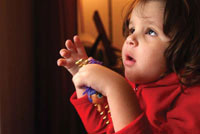Girls born with low birth rate develop autism more frequently, study says
Baby girls born prematurely with low weight run a higher risk of developing autism than prematurely born boys with low birth weight, a new study said.

The conclusion was made by a group of researchers from the US-based Center for Disease Control and Prevention. The scientists examined 565 children in Atlanta born from 1986 to 1993 with autism and compared them with children from a control group.
The research showed that a birth weight lower than 5.5 pounds was associated with a 2.3-fold increased risk for autism. In addition, it was found that girls had a three times or even a higher risk for developing autism.
The scientists also found that low birth weight and early preterm birth affected groups of children differently, depending on whether they had autism alone or autism and other developmental disabilities.
"What is new in this study is the in-depth look at the gender effect," Diana Schendel, lead health scientist at the National Center on Birth Defects and Developmental Disabilities at the CDC in Atlanta said.
Autism is a brain development disorder that impairs social interaction and communication, and causes restricted and repetitive behavior, all starting before a child is three years old. This set of signs distinguishes autism from milder autism spectrum disorders (ASD) such as Asperger syndrome.
Autism has a strong genetic basis, although the genetics of autism are complex and it is unclear whether ASD is explained more by multigene interactions or by rare mutations. In rare cases, autism is strongly associated with agents that cause birth defects. Other proposed causes, such as childhood vaccines, are controversial and the vaccine hypotheses lack convincing scientific evidence. Most recent reviews estimate a prevalence of one to two cases per 1,000 people for autism, and about six per 1,000 for ASD, with ASD averaging a 4.3:1 male-to-female ratio. The number of people known to have autism has increased dramatically since the 1980s, at least partly due to changes in diagnostic practice; the question of whether actual prevalence has increased is unresolved.
Autism affects many parts of the brain; how this occurs is poorly understood. Parents usually notice signs in the first two years of their child's life. Early behavioral or cognitive intervention can help children gain self-care, social, and communication skills. There is no cure. Few children with autism live independently after reaching adulthood, but some become successful, and an autistic culture has developed, with some seeking a cure and others believing that autism is a condition rather than a disorder.
Photo: schsuae.brinkster.net
Subscribe to Pravda.Ru Telegram channel, Facebook, RSS!



